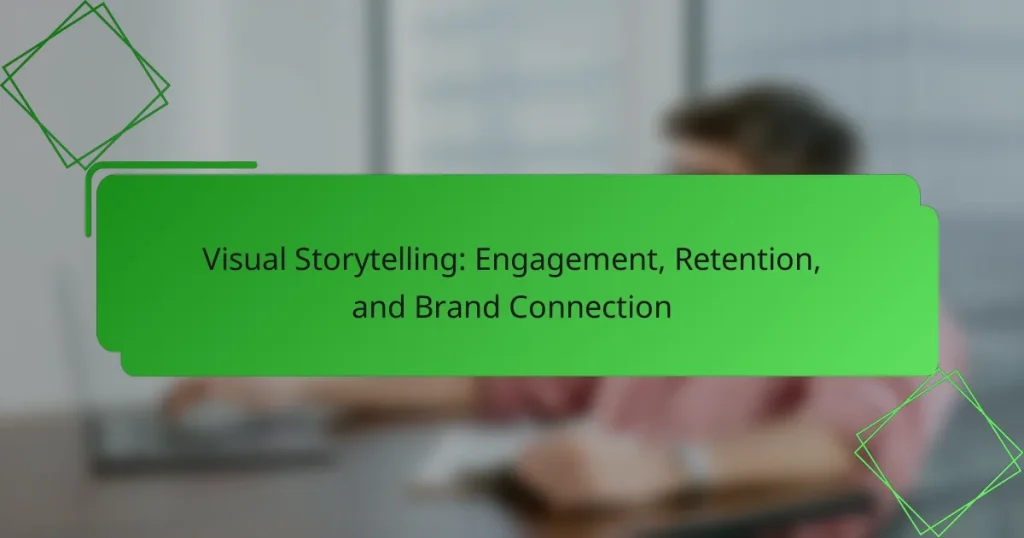Visual storytelling is a powerful tool that enhances user engagement by weaving compelling narratives with striking visuals. This approach not only captures attention but also evokes emotions, fostering a deeper connection between brands and their audiences. By strategically combining narrative structure and visual elements, companies can create memorable content that resonates and drives desired actions.
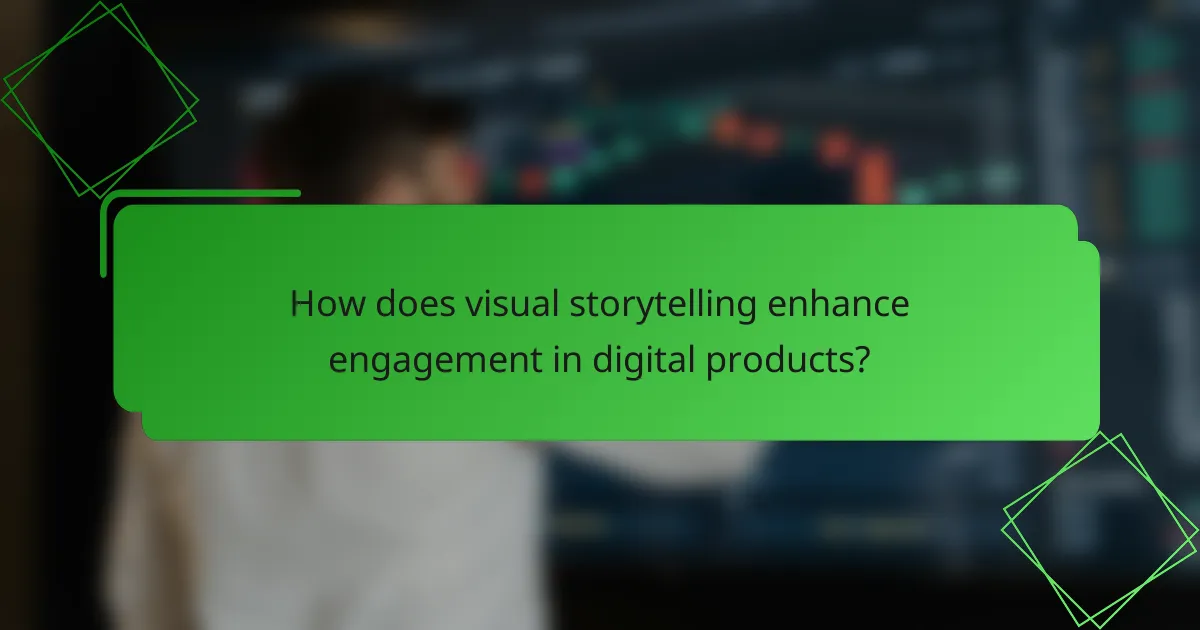
How does visual storytelling enhance engagement in digital products?
Visual storytelling enhances engagement in digital products by creating compelling narratives that resonate with users. By combining visuals with storytelling elements, brands can capture attention, evoke emotions, and foster a deeper connection with their audience.
Increased emotional connection
Visual storytelling fosters an emotional connection by using imagery, colors, and narratives that resonate with users’ experiences. For instance, a brand that shares customer success stories through visuals can evoke empathy and relatability, making users feel more connected to the brand.
To enhance emotional engagement, consider using authentic images and relatable scenarios that reflect your target audience’s values and aspirations. This approach can significantly increase brand loyalty and trust.
Improved information retention
Visual storytelling improves information retention by presenting data and concepts in a memorable format. Studies suggest that people retain information better when it is accompanied by visuals, as images can simplify complex ideas and enhance understanding.
When designing digital content, aim to incorporate infographics, charts, and videos that summarize key points visually. This can help users remember important information long after their initial interaction.
Higher user interaction rates
Higher user interaction rates are often a direct result of engaging visual storytelling. When users encounter visually appealing content, they are more likely to click, share, and comment, leading to increased engagement metrics.
To boost interaction, utilize interactive elements such as polls, quizzes, or clickable infographics within your visual narratives. These features encourage users to participate actively, enhancing their overall experience with your digital product.
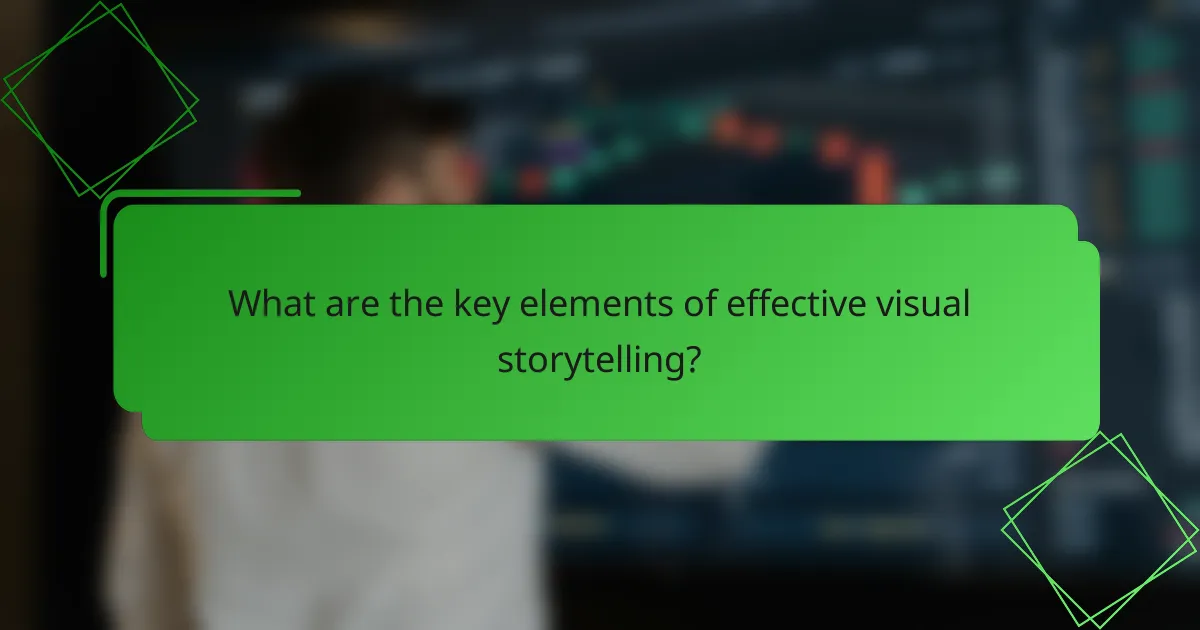
What are the key elements of effective visual storytelling?
Effective visual storytelling combines narrative structure, visual elements, and audience targeting to create engaging and memorable content. These components work together to enhance understanding and foster a deeper connection with the audience.
Narrative structure
A strong narrative structure is essential for guiding the audience through the visual story. It typically includes a clear beginning, middle, and end, helping to establish context, develop characters, and resolve conflicts. This structure keeps viewers engaged and encourages them to follow along.
When crafting a narrative, consider using techniques such as foreshadowing or cliffhangers to maintain interest. For example, a brand could introduce a problem in the beginning, showcase the journey to find a solution, and conclude with the successful outcome, reinforcing the brand’s value.
Visual elements
Visual elements, such as colors, typography, and imagery, play a crucial role in conveying the story’s message. These elements should align with the brand’s identity and evoke the desired emotions in the audience. For instance, warm colors can create a sense of comfort, while bold typography can convey strength.
Incorporating a mix of visuals, like infographics, videos, and illustrations, can enhance storytelling. Aim for a balanced composition that draws attention to key points without overwhelming the viewer. Consistency in style across all visuals is vital for maintaining coherence.
Audience targeting
Understanding the target audience is fundamental to effective visual storytelling. Tailoring the content to the audience’s preferences, interests, and demographics ensures that the message resonates. Conducting audience research can provide insights into what visuals and narratives will be most impactful.
Utilize analytics and feedback to refine your approach. For example, if a particular visual style or narrative resonates well with a segment of your audience, consider creating more content in that vein. Engaging with your audience through surveys or social media can also help identify their preferences and improve future storytelling efforts.
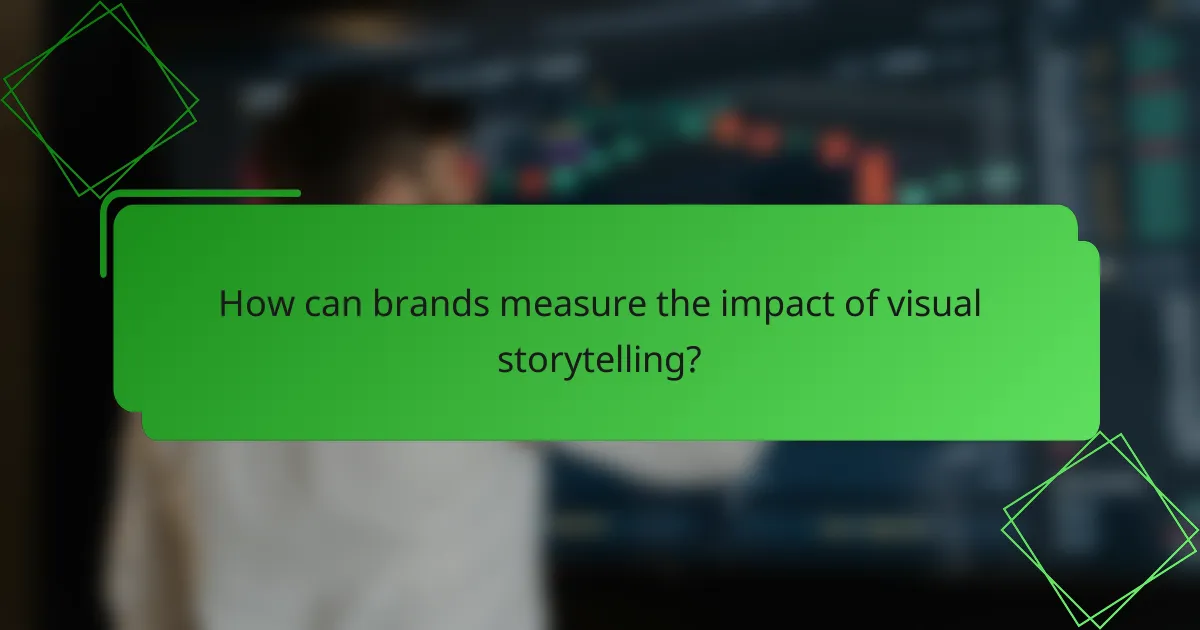
How can brands measure the impact of visual storytelling?
Brands can measure the impact of visual storytelling through various metrics that reflect engagement, conversion, and customer sentiment. By analyzing these indicators, companies can assess how effectively their visual content resonates with audiences and drives desired actions.
Engagement metrics
Engagement metrics include likes, shares, comments, and time spent on content. These figures provide insights into how well visual storytelling captures attention and encourages interaction. For instance, a video that retains viewers for several minutes typically indicates strong engagement.
To effectively track engagement, brands can use tools like Google Analytics or social media insights. Monitoring these metrics over time helps identify trends and the types of visuals that resonate best with the target audience.
Conversion rates
Conversion rates measure the percentage of users who take a desired action after interacting with visual content, such as making a purchase or signing up for a newsletter. A higher conversion rate often signifies that the visual storytelling effectively communicates the brand’s message and value proposition.
Brands should analyze conversion rates in relation to specific campaigns or content types. For example, a well-designed infographic might lead to a significant increase in sign-ups, while a compelling video could boost product sales. Regularly testing different visuals can optimize these rates.
Customer feedback
Customer feedback is crucial for understanding the impact of visual storytelling. Surveys, reviews, and direct comments can reveal how audiences perceive the visuals and their emotional responses. Positive feedback often indicates that the storytelling aligns well with customer expectations.
Brands can implement feedback mechanisms, such as post-purchase surveys or social media polls, to gather insights. Analyzing this feedback helps refine visual strategies and ensures that future content continues to engage and connect with the audience effectively.
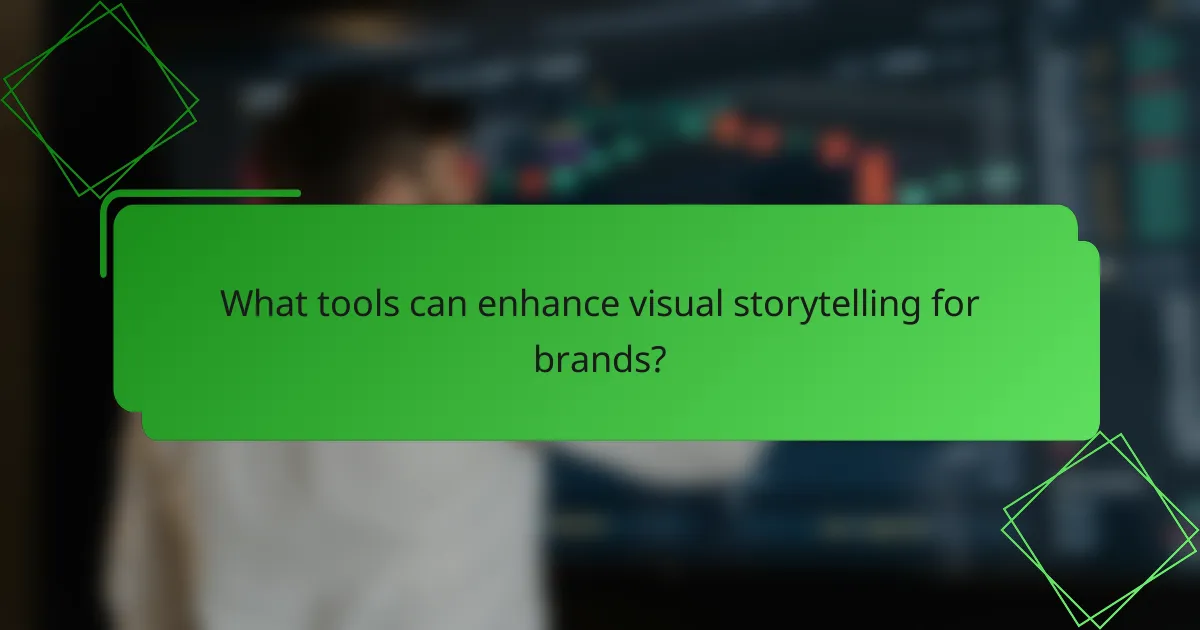
What tools can enhance visual storytelling for brands?
Several tools can significantly enhance visual storytelling for brands by providing user-friendly design and multimedia capabilities. These tools help create engaging content that captures audience attention and fosters brand connection.
Canva for design
Canva is a versatile graphic design platform that allows brands to create visually appealing graphics, social media posts, and marketing materials. With its drag-and-drop interface, users can easily customize templates or start from scratch, making design accessible even for those without a background in graphic design.
Key features include a vast library of images, fonts, and design elements. Brands can also collaborate in real-time, ensuring that team members can contribute to projects seamlessly. Consider using Canva for quick design tasks, as it offers both free and premium options to suit various budgets.
Adobe Spark for video
Adobe Spark is an excellent tool for creating short videos that tell a brand’s story. It provides templates and easy editing features that allow users to combine text, images, and video clips into compelling narratives. This tool is particularly useful for social media content, where engaging visuals can significantly boost viewer retention.
When using Adobe Spark, focus on keeping videos concise, ideally under a minute, to maintain audience interest. The platform also allows for branding customization, ensuring that videos align with the overall brand identity. Explore its features to create eye-catching videos that resonate with your target audience.
Visme for presentations
Visme is a powerful tool for creating interactive presentations that can enhance storytelling for brands. It offers a variety of templates and design elements that help users craft visually engaging slideshows. The ability to include animations and infographics makes presentations more dynamic and memorable.
When using Visme, prioritize clarity and visual hierarchy to ensure that key messages stand out. Incorporating data visualizations can also help communicate complex information effectively. This tool is ideal for both internal meetings and external pitches, making it a valuable asset for brand storytelling.

What are the best practices for implementing visual storytelling?
Effective visual storytelling hinges on a few key practices that enhance engagement and retention while building a strong brand connection. By focusing on consistency, leveraging user-generated content, and planning through storyboarding, brands can create compelling narratives that resonate with their audience.
Consistency in branding
Maintaining consistency in branding is crucial for effective visual storytelling. This means using the same color schemes, fonts, and imagery styles across all visual content to reinforce brand identity. Consistency helps audiences quickly recognize your brand, fostering trust and familiarity.
To achieve this, create a brand style guide that outlines visual elements and usage rules. Regularly review your content to ensure adherence to these guidelines, which can enhance brand recall by up to 80% over time.
Utilizing user-generated content
User-generated content (UGC) can significantly enhance visual storytelling by adding authenticity and relatability. Featuring real customers and their experiences with your brand can create a deeper emotional connection with your audience. UGC often showcases your products in real-life situations, making them more appealing.
Encourage customers to share their own stories through social media campaigns or contests. Highlighting this content on your platforms not only engages your audience but also builds a community around your brand, increasing loyalty and trust.
Storyboarding before production
Storyboarding is an essential step in visual storytelling that helps organize ideas and visualize the narrative flow before production begins. By sketching out scenes and key messages, you can identify potential gaps and ensure a cohesive story that aligns with your brand’s objectives.
Consider using digital tools or templates to create your storyboard, allowing for easy adjustments and collaboration among team members. This preparation can save time and resources during production, leading to a more polished final product that effectively communicates your message.
